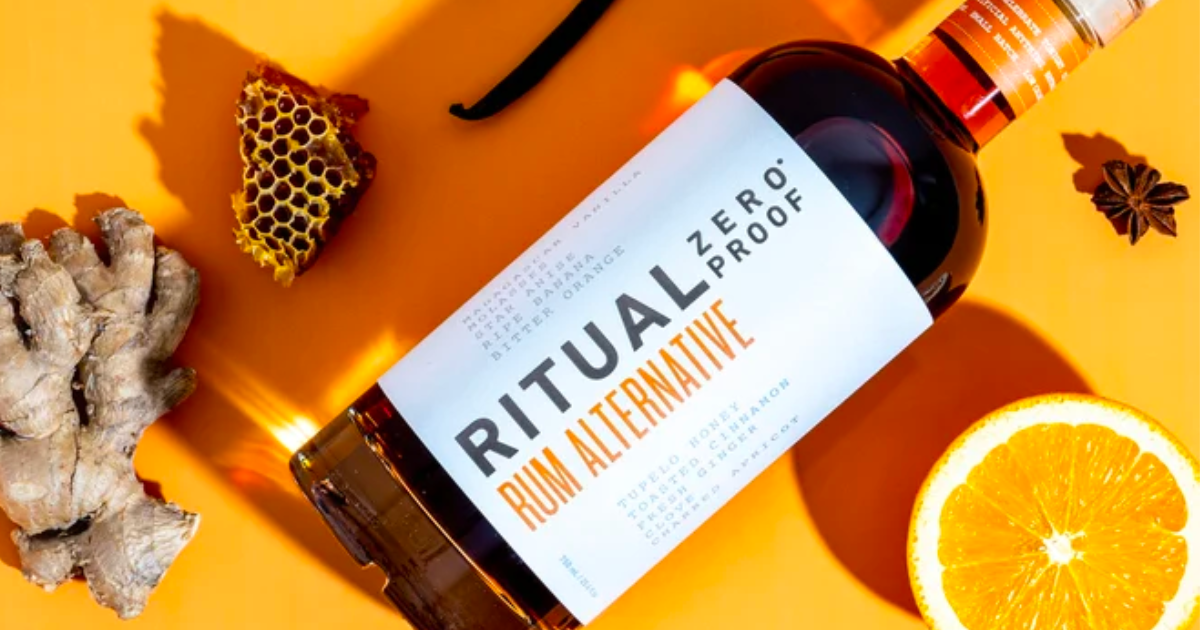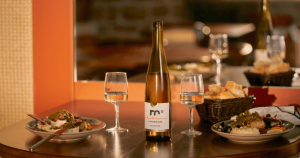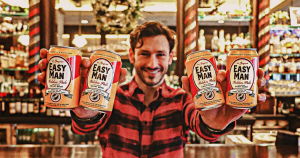In recent years, there’s been a surge in the demand for non-alcoholic versions of classic spirits, and rum is no exception. But what exactly is non-alcoholic rum? This guide offers a glimpse into rum alternatives, a category that’s expanding and evolving. Whether you’re a rum connoisseur or just curious, these non-alcoholic options provide a new way to experience the spirit.
About rum
Rum, primarily distilled from fermented sugarcane juice or its byproduct, molasses, traces its origins back several centuries.
The earliest iterations of rum can be linked to ancient India and China, where sugarcane was first fermented to produce alcoholic beverages. However, it was the Caribbean in the 17th century that saw the birth of rum as we recognize it today. With the European colonization of the islands and the establishment of sugarcane plantations, the discovery of molasses’ potential for distillation led to the widespread production of rum.
Rum’s rapid rise in popularity was not limited to the Caribbean. It soon found its way across the Atlantic, playing a pivotal role in the triangular trade among the colonies, Europe, and Africa. It even became a currency at one point, with sailors receiving rum as part of their daily rations, leading to the spirit’s association with piracy and naval tradition.
Over the centuries, rum has evolved, branched, and diversified, reflecting the regions where it’s produced. From the smooth, spiced variants of the Caribbean to the rich, dark rums of Central America, and the distinctive cachacas of Brazil, rum chronicles the ebb and flow of history.
What is non-alcoholic rum?
Non-alcoholic rum aims to capture the essence and flavor profile of traditional rum without the alcohol content. Through innovative distillation processes or blending natural flavors, producers craft a beverage that mimics the taste, aroma, and mouthfeel of its alcoholic counterpart. It’s designed for those who love the taste of rum but don’t want to consume alcohol.
How, exactly, is rum’s essence captured without alcohol? Let’s dive into the process.
- Flavor profile analysis: the first step involves a deep understanding of the flavor profile of traditional rum. Experts dissect and analyze the various notes, from the sweetness of sugarcane or molasses, to the smokiness from barrel aging, to the spices and fruitiness inherent in some rums.
- Sourcing ingredients: with a clear flavor target, producers then source non-alcoholic ingredients that can emulate these flavors. This could include sugarcane extracts, botanicals, spices like vanilla and cinnamon, and natural flavor compounds that mirror those found in traditional rum.
- Infusion and blending: ingredients are then infused or blended in a base, often water or a non-alcoholic syrup. Just as a master blender would blend various rums to achieve a desired taste, the same craftsmanship applies here. Ingredients may be steeped, simmered, or cold-infused to extract flavors. The process might require multiple iterations and adjustments to fine-tune the flavor.
- Aging (optional): while non-alcoholic rums don’t require aging for maturation as alcoholic spirits do, some producers might age their products in barrels to infuse them with woody, smoky, or toasted notes. This not only adds depth to the flavor but also provides an amber hue reminiscent of traditional rum.
- Filtering and bottling: the final product is filtered to remove any undissolved particles, ensuring clarity. It’s then bottled, labeled, and sealed, ready for consumption.
- Dealcoholization: the processes described above result in the production of little to no alcohol since there’s no fermentation. In contrast, other non-alcoholic drinks like wines and beers are made by dealcoholizing fermented, alcoholic liquids. As of 2024, we know of no brands dealcoholizing alcoholic rums to make non-alcoholic rums, but that may change in the future.
How to choose a non-alcoholic rum
As the world of non-alcoholic spirits expands, the options on the shelves multiply. For those seeking the essence of rum without the alcohol, here’s a concise guide to picking the best non-alcoholic rum for your palate:
- Flavor profile: the primary allure of any rum, alcoholic or not, lies in its flavor. When sampling non-alcoholic rums, look for those that capture the essence of traditional rum. This can encompass sweet notes of sugarcane, hints of vanilla or caramel, and even smoky or woody undertones from simulated aging. Some might also incorporate spices or fruit essences for added complexity.
- Ingredients: check the label for the list of ingredients. Premium non-alcoholic rums often use natural ingredients, botanicals, and extracts to achieve their flavor. Avoid brands that excessively rely on artificial flavorings or additives, as they can impart a synthetic taste.
- Brand reputation: as with any product, the reputation of the brand can be a significant indicator of quality. Research reviews, ratings, and testimonials to gauge the experiences of other consumers. Brands that have a history in the beverage industry or those highly regarded in the non-alcoholic spirits sector can often be trusted for quality and authenticity.
- Purpose: are you seeking a non-alcoholic rum for sipping or for cocktail mixing? Some variants might be tailored to serve as standalone drinks, offering a depth and complexity akin to aged alcoholic rums, while others may be crafted specifically to shine in mixed drinks, bringing out their best when combined with other ingredients.
- Personal preference: ultimately, the best non-alcoholic rum is one that aligns with your personal taste. Everyone’s palate is different; what might be a hit for one person could be a miss for another. Sampling a few different brands or varieties can help you pinpoint what resonates most with your preferences.
Remember, the non-alcoholic spirits sector is continuously evolving, with brands constantly innovating to improve their offerings. It’s an exciting time to explore, taste, and discover the nuances of non-alcoholic rum.
Comparing the best non-alcoholic rums
Here are five of my favorite non-alcoholic rums as of March 2024.
Monday’s non-alcoholic rum alternative is designed to mimic the flavors of traditional dark rum. With notes of caramel, toasted coconut, and vanilla, it’s reminiscent of the sweet and smoky profile found in some aged rums. The brand is often praised for its versatility, making it a good choice for mixing in cocktails or even sipping straight.
Ritual Zero Proof Rum Alternative
Ritual Zero Proof offers a robust flavor profile, harnessing a combination of sugarcane, vanilla, and toasted spices. Their alternative mirrors the warmth and depth of spiced rum, providing a balanced and aromatic experience. It’s a favorite among mixologists due to its ability to stand out in a variety of cocktails.
CleanCo Spiced Rum Alternative
CleanCo’s approach to non-alcoholic spirits is rooted in premium quality and taste. Their rum alternative, CleanRum, showcases a blend of spicy, sweet, and tropical flavors. The brand has been recognized for creating a non-alcoholic rum that retains a certain warmth, akin to its alcoholic counterpart, making it an excellent base for classics like mojitos or daiquiris.
Crafted to capture the essence of dark rum, ISH integrates flavors of clove, allspice, and vanilla. It’s particularly suited for those who lean towards a spiced rum profile, providing a rich and aromatic experience sans alcohol.
Fluère’s Spiced Cane stands out with its unique blend of botanicals. By using pure and essential oils from the botanicals, Fluère ensures a consistent flavor that captures the richness of rum. The dark roast variant boasts flavors of dark roasted coffee, cocoa, licorice, and tonka beans, offering a layered and complex taste profile, ideal for both sipping and crafting sophisticated mocktails.
Non-alcoholic rum cocktail ideas
For a simple serve that allows the flavors of the spirit to shine, this one’s hard to beat:
Non-Alcoholic Rum Old Fashioned
Ingredients:
- 2 oz non-alc rum
- 1 sugar cube or 1/2 tsp of simple syrup
- 2 – 3 dashes of Angostura bitters
- Orange or lemon twist for garnish
Muddle the sugar in the bottom of an Old Fashioned glass with the bitters. Fill the glass with large ice cubes and pour the rum over the ice. Stir gently for 20 – 30 seconds to chill and dilute the drink slightly. Garnish with a twist of orange or lemon. To do this, take a thin slice of peel, ensuring minimal pith. Twist it over the drink to release its essential oils and then drop it into the glass or place it on the rim.
For more advanced alcohol-free mixology, try your hand at one of the following mocktails:
Non-Alcoholic Mojito
Ingredients:
- 2 oz non-alc rum
- 10 fresh mint leaves, plus a sprig for garnish
- 1/2 lime, cut into 4 wedges
- 2 tablespoons sugar (or to taste)
- Ice cubes
- Soda water or club soda
Place the mint leaves and 1 lime wedge into a sturdy glass. Use a muddler to crush the mint and lime. Add 2 more lime wedges and the sugar to the glass, and muddle again to release more lime juice. Don’t pulverize it into pieces; the goal is to press the limes to release the maximum amount of juice. Fill the glass almost to the top with ice cubes. Add the non-alcoholic rum over the ice. Fill the rest of the glass with soda water or club soda and give it a good stir. If you’d like, you can add more sugar or lime at this point to taste. Garnish with the remaining lime wedge and a sprig of mint.
Non-Alcoholic Piña Colada
Ingredients:
- 2 oz non-alc rum
- 1 cup fresh pineapple chunks (or canned pineapple chunks in juice)
- 1/2 cup coconut cream or coconut milk
- 1/2 cup pineapple juice (if using fresh pineapple, you might not need as much juice)
- 1 cup ice cubes
- Pineapple slices and maraschino cherry for garnish
In a blender, combine the rum, pineapple chunks, coconut cream or coconut milk, pineapple juice, and ice cubes. Blend until smooth and creamy. Pour the blended mixture into chilled glasses. Garnish with a slice of pineapple and a maraschino cherry on top.
FAQs about non-alcoholic rums
Why would anyone drink non-alcoholic rum?
People choose non-alcoholic rum for various reasons, including lifestyle preferences, health considerations, and the desire to enjoy the social aspects of drinking a cocktail without alcohol’s effects.
What does non-alcoholic rum taste like?
Non-alcoholic rum aims to capture the essence and flavor profile of traditional rum without the alcohol content. However, the taste can vary based on the brand and the production method. Generally, non-alcoholic rum will strive to replicate the following characteristics of rum:
- Sweetness: traditional rum, especially dark and aged rums, often has a natural sweetness derived from sugarcane or molasses. Non-alcoholic versions will often emphasize this sweet note to replicate the sugary undertones of genuine rum.
- Spiciness: many rums, especially spiced rums, possess a mix of spices like vanilla, clove, cinnamon, and sometimes even pepper or tropical spices. Non-alcoholic versions often incorporate these flavors to give a spiced depth to the drink.
- Woody and smoky: aged rums take on woody flavors from the barrels they’re stored in. Some non-alcoholic rums will have added flavors or extracts to replicate this aged character.
- Fruity and tropical notes: many traditional rums have subtle fruity undertones, sometimes tropical, depending on where they’re made. Non-alcoholic versions might emphasize these fruity hints.
- Caramel and toasty notes: these come from the process of distilling and aging, and they’re often found in darker rums. Non-alcoholic rum alternatives will sometimes incorporate these flavors to give richness to the palate.
Does non-alcoholic rum actually taste like alcoholic rum?
It’s essential to note that, while non-alcoholic rum seeks to emulate the taste of traditional rum, there will always be some differences due to the absence of alcohol. The authenticity of the taste of non-alcoholic rum compared to its alcoholic counterpart varies among brands and production methods. Some non-alcoholic rums come close to replicating the depth, complexity, and nuances of traditional rum, thanks to advanced production techniques and flavor infusion methods. However, certain aspects intrinsic to aged alcoholic spirits, like the bite of alcohol and some depth from barrel aging, are challenging to replicate fully.
Is non-alcoholic rum good for you?
Non-alcoholic rum is emerging as a healthier alternative to its traditional alcoholic counterpart, owing largely to the absence of ethanol.
Ethanol, the primary intoxicating ingredient in alcoholic beverages, has been linked to a host of health issues, ranging from liver damage and addiction to metabolic disruptions and cognitive impairments when consumed excessively. Furthermore, the absence of alcohol means non-alcoholic rum usually contains fewer calories, potentially benefiting those mindful of their caloric intake.
Beyond the lack of ethanol, many non-alcoholic rum brands emphasize natural ingredients, eschewing artificial flavors and sweeteners, which can be detrimental to health in their own right. This focus on natural components often results in a beverage that aligns more closely with health-conscious consumer preferences.
What is the best non-alcoholic rum for cocktails?
When deciding on the best non-alcoholic rum for cocktails, you might consider:
- Sampling: taste is personal. If possible, sample a few options to decide which one resonates with your palate.
- Reading reviews: online reviews can offer insights on how a particular brand performs in cocktails. My five favorites are listed above but it’s a personal choice.
- Versatility: Consider how the non-alcoholic rum pairs with various mixers and if it can be used in a wide range of mocktails.
Lastly, as the non-alcoholic spirits industry is rapidly evolving, new brands and improved formulations frequently emerge. Staying updated with industry news and trends can help you discover new and exciting options for your cocktails.
What is the best non-alcoholic rum for a Dark and Stormy?
When choosing a non-alcoholic rum for a Dark and Stormy, consider the following:
- Taste profile: opt for a brand that retains the smooth, sugarcane-forward profile of traditional rum.
- Mouthfeel: one of the challenges of non-alcoholic spirits is replicating the warmth and body of alcohol. See reviews or taste test to find one that isn’t too thin or watery.
- Mixability: ensure that the non-alcoholic rum mixes well with other ingredients, especially if you’re planning to make cocktails.
It’s always a good idea to check the latest reviews or visit specialized stores where you can sample or get recommendations. As the non-alcoholic category is booming, more and more options are likely to emerge, potentially offering even closer approximations to the real thing.
For more from Douglas, follow him on LinkedIn.






